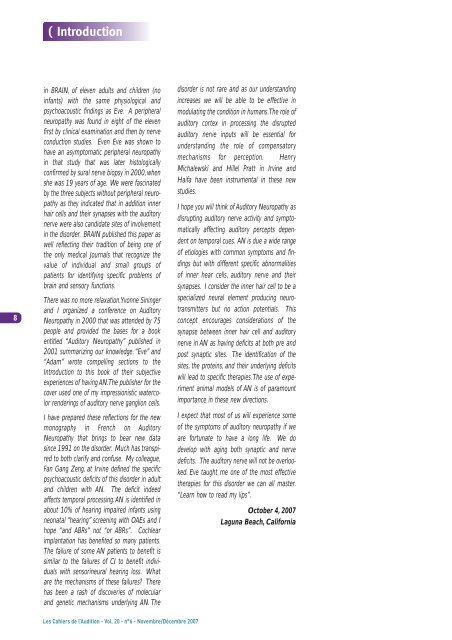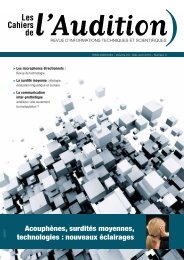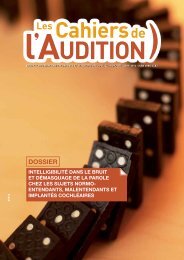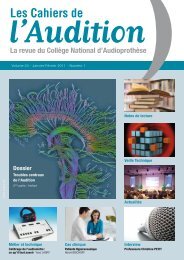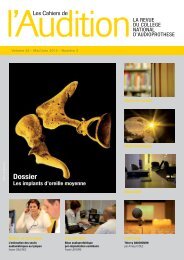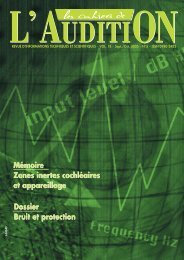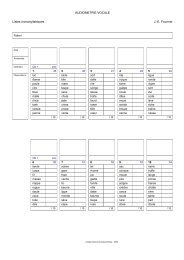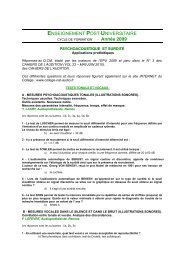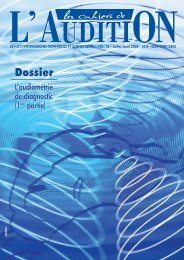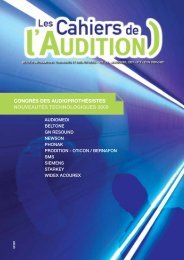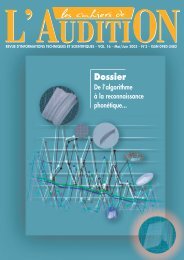la neuropathie auditive / désynchronisation auditive - Collège ...
la neuropathie auditive / désynchronisation auditive - Collège ...
la neuropathie auditive / désynchronisation auditive - Collège ...
Create successful ePaper yourself
Turn your PDF publications into a flip-book with our unique Google optimized e-Paper software.
( Introduction8in BRAIN, of eleven adults and children (noinfants) with the same physiological andpsychoacoustic findings as Eve. A peripheralneuropathy was found in eight of the elevenfirst by clinical examination and then by nerveconduction studies. Even Eve was shown tohave an asymptomatic peripheral neuropathyin that study that was <strong>la</strong>ter histologicallyconfirmed by sural nerve biopsy in 2000, whenshe was 19 years of age. We were fascinatedby the three subjects without peripheral neuropathyas they indicated that in addition innerhair cells and their synapses with the auditorynerve were also candidate sites of involvementin the disorder. BRAIN published this paper aswell reflecting their tradition of being one ofthe only medical Journals that recognize thevalue of individual and small groups ofpatients for identifying specific problems ofbrain and sensory functions.There was no more re<strong>la</strong>xation.Yvonne Siningerand I organized a conference on AuditoryNeuropathy in 2000 that was attended by 75people and provided the bases for a bookentitled “Auditory Neuropathy” published in2001 summarizing our knowledge. “Eve” and“Adam” wrote compelling sections to theIntroduction to this book of their subjectiveexperiences of having AN.The publisher for thecover used one of my impressionistic watercolorrenderings of auditory nerve ganglion cells.I have prepared these reflections for the newmonography in French on AuditoryNeuropathy that brings to bear new datasince 1991 on the disorder. Much has transpiredto both c<strong>la</strong>rify and confuse. My colleague,Fan Gang Zeng, at Irvine defined the specificpsychoacoustic deficits of this disorder in adultand children with AN. The deficit indeedaffects temporal processing.AN is identified inabout 10% of hearing impaired infants usingneonatal “hearing” screening with OAEs and Ihope “and ABRs” not “or ABRs”. Cochlearimp<strong>la</strong>ntation has benefited so many patients.The failure of some AN patients to benefit issimi<strong>la</strong>r to the failures of CI to benefit individualswith sensorineural hearing loss. Whatare the mechanisms of these failures? Therehas been a rash of discoveries of molecu<strong>la</strong>rand genetic mechanisms underlying AN. Thedisorder is not rare and as our understandingincreases we will be able to be effective inmodu<strong>la</strong>ting the condition in humans.The role ofauditory cortex in processing the disruptedauditory nerve inputs will be essential forunderstanding the role of compensatorymechanisms for perception. HenryMichalewski and Hillel Pratt in Irvine andHaifa have been instrumental in these newstudies.I hope you will think of Auditory Neuropathy asdisrupting auditory nerve activity and symptomaticallyaffecting auditory percepts dependenton temporal cues. AN is due a wide rangeof etiologies with common symptoms and findingsbut with different specific abnormalitiesof inner hear cells, auditory nerve and theirsynapses. I consider the inner hair cell to be aspecialized neural element producing neurotransmittersbut no action potentials. Thisconcept encourages considerations of thesynapse between inner hair cell and auditorynerve in AN as having deficits at both pre andpost synaptic sites. The identification of thesites, the proteins, and their underlying deficitswill lead to specific therapies.The use of experimentanimal models of AN is of paramountimportance in these new directions.I expect that most of us will experience someof the symptoms of auditory neuropathy if weare fortunate to have a long life. We dodevelop with aging both synaptic and nervedeficits. The auditory nerve will not be overlooked.Eve taught me one of the most effectivetherapies for this disorder we can all master.“Learn how to read my lips”.October 4, 2007Laguna Beach, CaliforniaLes Cahiers de l’Audition - Vol. 20 - n°6 - Novembre/Décembre 2007


